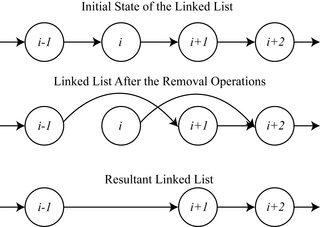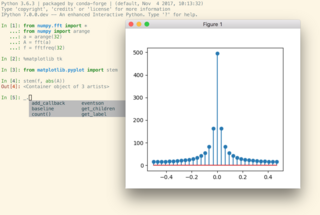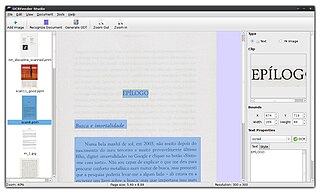Related Research Articles

In computer science, mutual exclusion is a property of concurrency control, which is instituted for the purpose of preventing race conditions. It is the requirement that one thread of execution never enters a critical section while a concurrent thread of execution is already accessing said critical section, which refers to an interval of time during which a thread of execution accesses a shared resource or shared memory.
In multi-threaded computer programming, a function is thread-safe when it can be invoked or accessed concurrently by multiple threads without causing unexpected behavior, race conditions, or data corruption. As in the multi-threaded context where a program executes several threads simultaneously in a shared address space and each of those threads has access to every other thread's memory, thread-safe functions need to ensure that all those threads behave properly and fulfill their design specifications without unintended interaction.
In computer science, a lock or mutex is a synchronization primitive that prevents state from being modified or accessed by multiple threads of execution at once. Locks enforce mutual exclusion concurrency control policies, and with a variety of possible methods there exist multiple unique implementations for different applications.
Peterson's algorithm is a concurrent programming algorithm for mutual exclusion that allows two or more processes to share a single-use resource without conflict, using only shared memory for communication. It was formulated by Gary L. Peterson in 1981. While Peterson's original formulation worked with only two processes, the algorithm can be generalized for more than two.

OpenMP is an application programming interface (API) that supports multi-platform shared-memory multiprocessing programming in C, C++, and Fortran, on many platforms, instruction-set architectures and operating systems, including Solaris, AIX, FreeBSD, HP-UX, Linux, macOS, and Windows. It consists of a set of compiler directives, library routines, and environment variables that influence run-time behavior.
In computer science, an algorithm is called non-blocking if failure or suspension of any thread cannot cause failure or suspension of another thread; for some operations, these algorithms provide a useful alternative to traditional blocking implementations. A non-blocking algorithm is lock-free if there is guaranteed system-wide progress, and wait-free if there is also guaranteed per-thread progress. "Non-blocking" was used as a synonym for "lock-free" in the literature until the introduction of obstruction-freedom in 2003.

PyQt is a Python binding of the cross-platform GUI toolkit Qt, implemented as a Python plug-in. PyQt is free software developed by the British firm Riverbank Computing. It is available under similar terms to Qt versions older than 4.5; this means a variety of licenses including GNU General Public License (GPL) and commercial license, but not the GNU Lesser General Public License (LGPL). PyQt supports Microsoft Windows as well as various kinds of UNIX, including Linux and MacOS.
Google File System is a proprietary distributed file system developed by Google to provide efficient, reliable access to data using large clusters of commodity hardware. Google file system was replaced by Colossus in 2010.
In computer architecture, the test-and-set CPU instruction is designed to implement mutual exclusion in multiprocessor environments. Although a correct lock can be implemented with test-and-set, the test and test-and-set optimization lowers resource contention caused by bus locking, especially cache coherency protocol overhead on contended locks.
A distributed algorithm is an algorithm designed to run on computer hardware constructed from interconnected processors. Distributed algorithms are used in different application areas of distributed computing, such as telecommunications, scientific computing, distributed information processing, and real-time process control. Standard problems solved by distributed algorithms include leader election, consensus, distributed search, spanning tree generation, mutual exclusion, and resource allocation.
In computer science and engineering, transactional memory attempts to simplify concurrent programming by allowing a group of load and store instructions to execute in an atomic way. It is a concurrency control mechanism analogous to database transactions for controlling access to shared memory in concurrent computing. Transactional memory systems provide high-level abstraction as an alternative to low-level thread synchronization. This abstraction allows for coordination between concurrent reads and writes of shared data in parallel systems.

Computational Engineering is an emerging discipline that deals with the development and application of computational models for engineering, known as Computational Engineering Models or CEM. Computational engineering uses computers to solve engineering design problems important to a variety of industries. At this time, various different approaches are summarized under the term Computational Engineering, including using computational geometry and virtual design for engineering tasks, often coupled with a simulation-driven approach In Computational Engineering, algorithms solve mathematical and logical models that describe engineering challenges, sometimes coupled with some aspect of AI, specifically Reinforcement Learning.

IPython is a command shell for interactive computing in multiple programming languages, originally developed for the Python programming language, that offers introspection, rich media, shell syntax, tab completion, and history. IPython provides the following features:
In computer science, false sharing is a performance-degrading usage pattern that can arise in systems with distributed, coherent caches at the size of the smallest resource block managed by the caching mechanism. When a system participant attempts to periodically access data that is not being altered by another party, but that data shares a cache block with data that is being altered, the caching protocol may force the first participant to reload the whole cache block despite a lack of logical necessity. The caching system is unaware of activity within this block and forces the first participant to bear the caching system overhead required by true shared access of a resource.
pexec is a command-line utility for Linux and other Unix-like operating systems which allows the user to execute shell commands in parallel. The specified code can be executed either locally or on remote hosts, in which case ssh is used to build a secure tunnel between them. Similar to shell loops, a variable is changed as the loop starting the tasks iterates, so that many values can get passed to the specified command or script. pexec is a free software utility, and part of the GNU Project. It is available under the terms of GPLv3, and is part of the current Debian stable release.
Intel Parallel Studio XE was a software development product developed by Intel that facilitated native code development on Windows, macOS and Linux in C++ and Fortran for parallel computing. Parallel programming enables software programs to take advantage of multi-core processors from Intel and other processor vendors.

OCRFeeder is an optical character recognition suite for GNOME, which also supports virtually any command-line OCR engine, such as CuneiForm, GOCR, Ocrad and Tesseract. It converts paper documents to digital document files and can serve to make them accessible to visually impaired users.
The following table compares notable software frameworks, libraries and computer programs for deep learning.
PyTorch is a machine learning library based on the Torch library, used for applications such as computer vision and natural language processing, originally developed by Meta AI and now part of the Linux Foundation umbrella. It is recognized as one of the two most popular machine learning libraries alongside TensorFlow, offering free and open-source software released under the modified BSD license. Although the Python interface is more polished and the primary focus of development, PyTorch also has a C++ interface.

Google JAX is a machine learning framework for transforming numerical functions. It is described as bringing together a modified version of autograd and TensorFlow's XLA. It is designed to follow the structure and workflow of NumPy as closely as possible and works with various existing frameworks such as TensorFlow and PyTorch. The primary functions of JAX are:
- grad: automatic differentiation
- jit: compilation
- vmap: auto-vectorization
- pmap: SPMD programming
References
- ↑ "Automatic Mutual Exclusion". Microsoft Research. Archived from the original on 2012-06-18. Retrieved 2012-08-09.
- ↑ Armin Rigo (9 August 2012). "Multicore Programming in PyPy and CPython". PyPy Status Blog. Retrieved 2012-08-09.